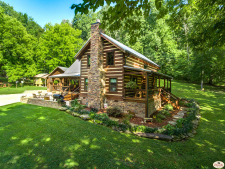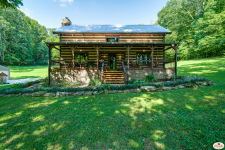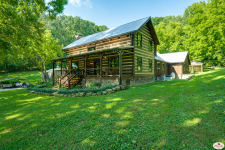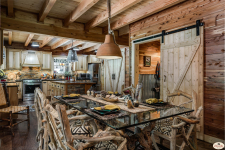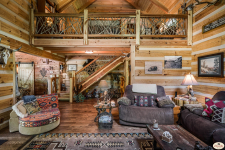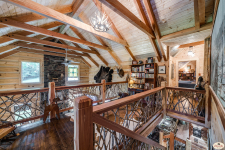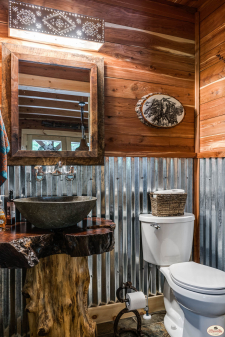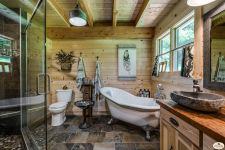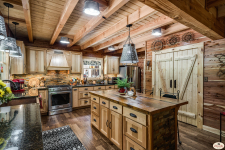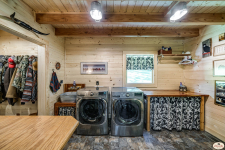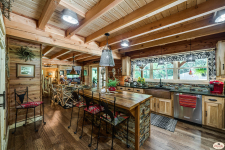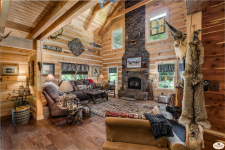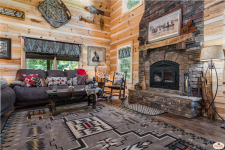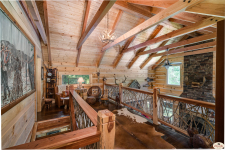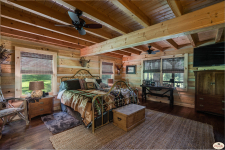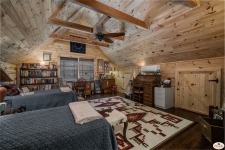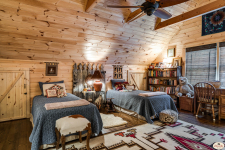
Sacred Places
by Claudia Johnson
A heritage-loving couple’s determination and ingenuity forged a home that encapsulates their love of nature, history, craftsmanship and one another.
More than 200 years ago settlement of this land began. Before that it was bountiful Cherokee and Creek hunting ground. Earlier still, indigenous peoples made their way through lush valleys, alongside clear streams and across forested hills toward summering lands, where they planted squash and corn and lived off wild game until their circle of life led them back to Southern winter camps.
It is in this sacred place that Cindy and Roger Shaneyfelt built their log cabin, just as early settlers would have done, on the swell of rich, dark earth, backed by abundant woodland and fronted by a nourishing creek.
“We’d always wanted a log home that resembled an historic Southern cabin,” said Cindy, whose 2,980-square-foot cabin appears to have been in place for centuries but was finished only four years ago.
The Shaneyfelts long ago purchased 50 verdant acres near the Alabama border in Southern Middle Tennessee, but it took time, commitment and an inordinate amount of manual labor to prepare the site for building the home they’d sketched on graph paper and dreamed of creating together.
“We did SO much cleaning up,” Cindy recalled with a shudder. “Car parts and just trash. It was awful. Overgrown, too. We hauled off more than 300 tires from here!”
When the land was finally ready, the couple selected Honest Abe Log Homes, headquartered in Moss, Tennessee, with sales representative Ethan Birdwell as navigator, to help design, manufacture and erect the home.
“We wanted the old chinked-style square logs and with the spline between
each log,” Roger said. “We liked Honest Abe’s log system, which has less settlement and structure shrinkage. Honest Abe was also very willing to work with us on the custom design and changes.”
Honest Abe designer Melissa Copas drafted the completely custom plan from the couple’s original drawing.
“We designed the home based on our specific needs,” said Cindy, who had lived in both a 150-year-old log cabin of square poplar logs and a more modern house with round pine logs, so she understood what they needed to achieve with the new design. “Ethan would send us a draft, and we’d revise it again. He never complained about our many revisions – seven, I think.”
The final L-shaped plan incorporates a front-facing one-and-one-half story, hand-hewn log structure with a heavy timber roof system, while the “L” is of traditional frame and truss construction covered with wood board and batten. Entering from the front porch, an entrance hall is flanked by a living room and master bed-bath suite. Also on the main floor are the kitchen, laundry, dining room, mudroom and half bath. Two bedrooms and a full bath are upstairs.
“Roger wanted this house to appear historic from the exterior, and I wanted a vaulted ceiling in the living room,” Cindy said. “With Honest Abe, we were able to accomplish that.”
When the custom package was cut and delivered for construction, an Honest Abe construction crew headed by Brian Ritter was dispatched.
“It took only 13 days for the erection of the logs and the framing of the back part of the house,” Cindy said, still amazed at the speed and ease of drying in the cabin. “Brian’s crew was just awesome! Marty Wright, our contractor, took over after that, along with Rob Tucker and his carpentry crew, and it took us about a year to get it completed.”
During the course of that year, on Oct. 3, 2015, Cindy and Roger were married on the 8’ wide, full-length, covered front porch before an intimate gathering of well-wishing family and friends.
Channeling, perhaps, the cooperative spirit of couples who’d settled the land before them, Cindy and Roger worked side by side to achieve finished living spaces, both indoors and outside, that they had envisioned.
From native Eastern red cedar wood acquired from a local sawmill, they planed and hung the horizontal boards covering several interior walls and lining closets and pantries. Cedar tree trunks were fashioned into pedestals for sinks and tables. Cedar slabs were used as front porch boards and interior and exterior stair treads. A live-edge red cedar slice became the staircase skirting. They cut and dried privet bushes, and the branches became a dramatic substitute for wood spindles in the balcony and star railings
Roger’s wood working expertise coupled with Cindy’s gift for decorating produced what can best be described as “traditional-eclectic.”
They hunted antique and junk stores for unusual items to convert into fixtures, like the vintage olive bucket that’s now a kitchen light, or the galvanized wash tub repurposed as a laundry sink or the motorcycle spring that extends a terra cotta light fixture over the dining table.
From the weathered boards of a century-old Tennessee barn, Roger built countertops for the hickory kitchen island and bathroom counters. He crafted walnut wood from their own trees into mirror frames, table tops and a mantlepiece for the floor to ceiling manufactured stone living room fireplace. He hollowed out a cedar log for plumbing, topped it with a vintage 6” slice of rosewood and installed a stone vessel and reproduction faucets to create a powder room laboratory that’s pure art.
In the laundry room leading to a 768-square-foot double garage, Roger made work and storage spaces from fresh red cedar, while Cindy sewed curtains and curated a gallery of cat art with paintings and needlework by her and her parents, who were each talented artists.
Throughout the house hang paintings by Cindy’s father, Bill Seward, and in every room there’s a reminder of Cindy’s mother, Nancy Robinette, whose fine needlework is displayed in frames.
“My mother passed away in 2014,” Cindy explained, adding that she’s woven pieces from her mother’s life into her décor. “The home had to have a dining room area big enough for my mother’s glass top table with a cypress root base and four driftwood chairs.”
In a life inconceivable to both Roger and Cindy’s Cherokee ancestors who roamed the land or the pioneers who tamed it, the couple reclaimed it for their own, sharing it with their three dogs, two cats and the wildlife that beckoned and sustained generations before them.
“We have deer and turkey come in our yard all the time,” Cindy said. “We even have a possum that has been coming in our garage to eat the cat food and sleep in a little bed we have in there. We are off the beaten path. Peaceful. Content. Just enjoying life at a slower pace. It’s like a vacation retreat that we get to live in all the time.”
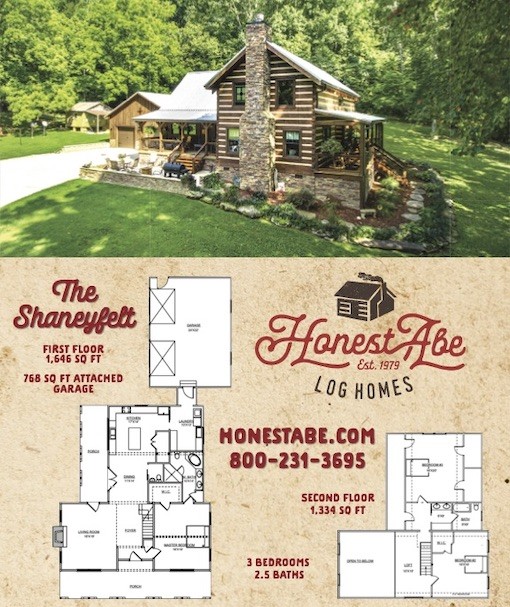
Shaneyfelt Square Chinked
The Shaneyfelt log cabin is created from a custom concept by the homeowners and was drafted into plans by Honest Abe’s design department, manufactured in our mill and dried in by our in-house construction crew. The home reflects the homeowners’ love of historic log cabins.
Details are important to the Shaneyfelts
Roger and Cindy Shaneyfelt were inspired by the chinked, square-log cabins erected by early settlers to their area in southern Middle Tennessee. Plans for the 2,980-square-foot cabin were drafted by Honest Abe Log Homes – which manufactured and built the home – from an original concept drawing by the couple. Each of the Eastern white pine logs was hewed by hand with an antique adz by Honest Abe craftsmen.
Cindy pays homage to her Cherokee ancestry by incorporating Native American art, pottery and fabric pieces into an eclectic décor. Designed for comfort, the living room with its wood-burning fireplace and vaulted ceiling is decorated with animal skins, an antique tobacco basket, a stained glass window from Cindy’s late mother and tables of driftwood, logs and branches.
The dining room was configured to accommodate a glass top table with a cypress root base and four driftwood chairs that had belonged to Cindy’s mother, who died in 2014, two years before the cabin was completed. The clay funnel light fixture is suspended by a motorcycle spring.
With its pinecones, birch bark basket, branch slice runner, woodland creatures and twig-handled flatware, the dining table, as with much of the home’s décor, reflects the Shaneyfelts’ love for nature. The kitchen and dining room are covered in horizontal native red cedar planks the couple planed and hung. Double barn doors conceal a cedar pantry, while a single sliding barn door offers privacy to the corrugated tin and red cedar finished half bath.
Hickory cabinets, a copper farmhouse sink, the slate tile backsplash, metal light fixtures and Uba Tuba granite countertops create a feast of textures in the kitchen. The island’s oak top was made by Roger from 100-year-old reclaimed barn wood. Vintage metal chairs with animal silhouette backs were painted black and recovered in Native American print fabric by Cindy.
The Shaneyfelts creatively tackled the challenge of adding lighting to an exposed beam ceiling. They affixed inverted galvanized buckets with a single bright lightbulb to a board between the Douglas fir rafters supporting the pine tongue-and-groove ceilings. Over the island, they hung an antique olive bucket they fashioned into a light fixture. They were surprised to find online the matching small reproduction olive bucket fixtures they use over the sink.
The second upstairs bedroom doubles as a guest room for the grandchildren and an office and sewing room for Cindy. She’s collected special pieces from her mother’s home as well as items meaningful to her and Roger as a couple. The picket fence was a gift from Roger when they were dating. Cindy and her mother embroidered most of the wall hangings and pillows. Roger built attractive knee wall doors for handy access to storage.
The natural finish of the hand-hewn logs creates a pleasing contrast to the stained pine floors on the 1,334-square-foot second floor. Cindy chose to furnish the guest bedroom with treasured pieces like the walnut chests, half-hexagonal cottage painted night stands and a mid-20th-century birch bedroom suite from her mother’s home. Paintings by her father and intricate cross stitch pillows adorn the walls and chairs.
Dark-stained engineered hardwood floors are used throughout the 1,646-square-foot main floor. The Shaneyfelts keep the master bedroom light using lightweight bamboo shades. With the home’s secluded, country setting only minimal window coverings are necessary.
The master bathroom has a large walk-in shower and a porcelain clawfoot tub. The Shaneyfelts crafted a light fixture from a funnel found in an old barn on their 50-acre property. A small dressing stool was made from an old tractor seat.
Custom designed and built hickory cabinetry is topped by reclaimed barn wood and dual stone sinks in the guest bath.
The second floor’s full bath has a corrugated tin ceiling and dark stained pine flooring. The red cedar log bench was handmade by an elderly craftsman in Kentucky.
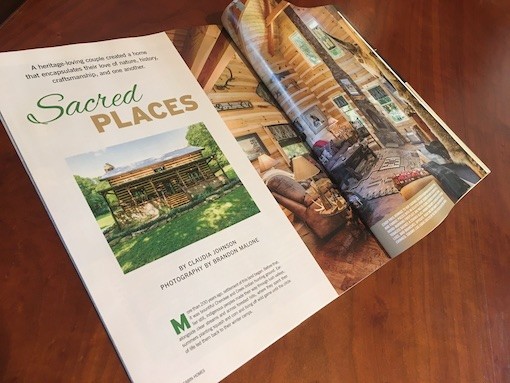
In a Log Cabin Homes article called “Sacred Places,” writer Claudia Johnson tells the story of a heritage-loving couple’s determination and ingenuity to forge a home that encapsulates their love of nature, history, craftsmanship and one another. Brandon Malone’s vivid photos highlight the cabin’s craftsmanship and the homeowners’ eye for detail.
Story by Claudia Johnson
Originally published in Log Cabin Homes
Log home manufacturer: Honest Abe Log Homes
Photography by Brandon Malone

